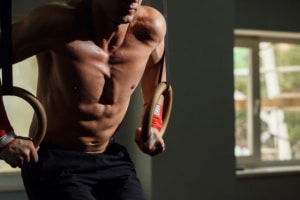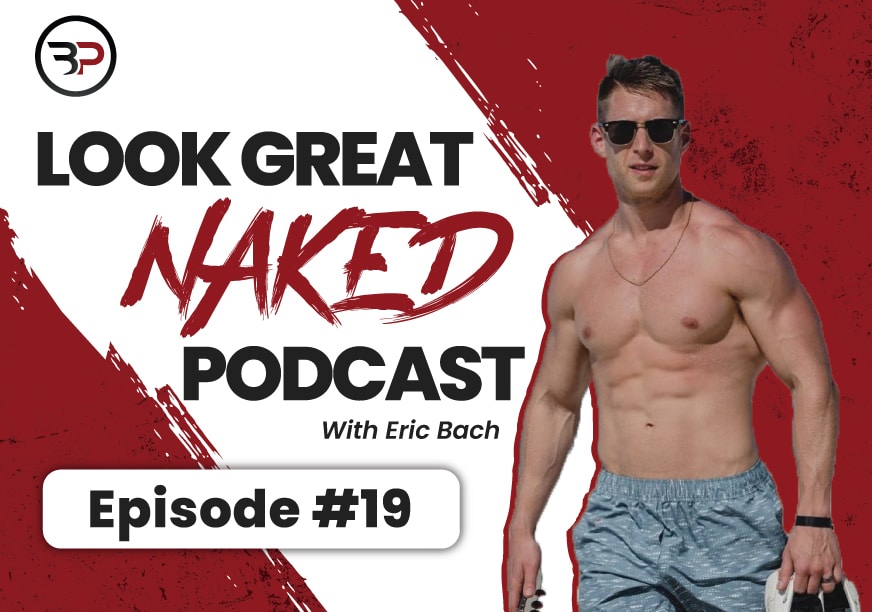How To Build A Muscular Chest
September 18, 2018
Here are 7 tips to build a chiseled chest. To sweeten the pot, I’m also giving you the best 10 exercises and a chance to add inches to your chest. Let’s roll.
Most men can relate to this. As a sunken-chested skinny guy, all I wanted was a muscular and powerful chest. As soon as I set foot in the gym, I darted straight to the bench press.
I wanted muscles stronger than an ox that made me feel powerful and confident. I figured a big bench would help, right?
Well, no.
I learned the hard way that the flat barbell bench press sucks as a chest builder. Despite benching two times my bodyweight, I still had a pair of pancake pecs.
It wasn’t until I took an unconventional approach…the same approach I’m about to share with you… that I built a chiseled chest.
Here are 7 training tactics to turn your pecs from flabby, flat, or flaccid to powerful and armor-plated pecs.
Tip #1: Use Bench For Strength, Not Size
The bench press is an excellent exercise for building upper body strength and creating mechanical tension, a key factor for muscle growth. The bad news? It sucks for maximizing chest growth.
What’s the deal?
Beginners will make some gains on the barbell bench press, but as you get stronger you place more stress on your anterior deltoids and triceps than on your chest. Again, these muscles are important but aren’t going to help you build your chest. I promise as a bench-lovin’ bro, I’m not blowing smoke up your ass.
This study compared benching with 70% 1-RM max versus 85% 1-Rm and found muscular activation in the pecs did not increase; the increased muscle activation to build a bigger bench came primarily from the shoulders and triceps.
Translation?
Heavy benching will get you stronger than an ox and please your ego, but benching heavy as most dudes do in the gym isn’t doing anything additional for chest development. If growing eye-popping chesticles is your goal, leave your ego at the door and drop the weight your bench press. You’ll spare your shoulders. At the very least, use bands or chains to overload your triceps and shoulders will spare your joints.
Sacrilege? Maybe. I love the bench, too. But here’s the shocker: the flat barbell bench press sucks for building your chest.
Tip #2: Since You’re Going To Bench…Make It An Incline Bench
The majority of lifters emphasize their mid and lower pecs with a plethora of decline presses, flyes, and flat bench work. These are all fine exercises. But if your goal is to build button-popping pecs, your new best friend is the incline bench.
The incline press will hammer the clavicular head of your pec, up near your collarbone. This gives your chest a full look, rather than the overdeveloped, saggy chest you see with many lifters.
Take a 3-4 second eccentric (negative) on each rep, touch your chest, and squeeze your chest throughout every rep.
When you combine the incline angle, heavyweight, and metabolic stress from a longer-eccentric tempo you have a triple-threat training stimulus to build a big chest, fast.
Tip #3: Start With Isolation Work
You’ll have one hell of a time growing any muscle if you can’t feel it flex through a movement. Your chest is no different.
Here’s the fix:
Before you hop on the bench or any other heavy compound lift, do 2-3 activation sets of 10-12 reps and a one-second flex at the top with a cable crossover, dumbbell fly, or machine fly.
All three of these lifts will hit your sternal pic fibers, aka your “middle chest” in bro-language. These fibers are oft-neglected in the barbell bench press. A few activation sets before your heavy strength work will help you feel your pecs and help you grow faster.
Tip #4: Hit Your Chest From Multiple Angles
Excuse the brief anatomy lesson but here it comes. Your pecs are a unique beast. The attach at your sternum, rib cage, collarbone, and to your humerus. Humerus, I know.

You can break your pecs into three areas:
- the clavicular fibers (upper pecs)
- the sternal fibers (middle pecs)
- and the good ole’ lower chest.
Because of the sheer size of the pec and the varying roles, training from different angles is necessary for optimal growth.
Since most lifters go apeshit on the bench press, the adduction (fly or crossover movements) are often underutilized. So are incline and decline angles. As a general rule of thumb, decline angles will hit your lower pec fibers. Flat angles will hit your lower-middle pec fibers. Incline angles will dig into your clavicular-upper pec fibers.
In my experience, most guys struggle with building their upper chest. In this case, your exercise selection could look like this.
Example:
Incline Barbell Bench Press
15 Deg. Incline Dumbbell Bench Press
Low-to-High Cable Crossover
Keep it simple and work through a variety of rep ranges, tempos, and angles to maximize the growth of your chest.
Tip #5: Chains, Rings, Bodyweight and Things
Most lifters have achy, sore, and beat up shoulders, which makes training chest as fun as sticking yourself in the eye with an ice-pick.
In this case, push-ups should be a staple movement in your training.
Bodyweight training gets a bad rap for being “too easy” when in most cases, lifters don’t use them correctly.
Push-ups become a top-notch chest builder once you manipulate body positions. Try:
- elevating your feet
- slowing your rep speed
- squeezing your hands together to activate your pecs
- using suspension trainers
Continue getting stronger with more advanced progressions with sets of 8-15, as you would in any other exercise.
Once you can do 3×8 on one variation, move to the next:
Hands elevated push up→ push up→ Feet elevated push-up→ Weighted push-up→ Suspended pushup (rings)–> Weighted resisted push-up→ Suspension flyes (rings)–> Weighted resisted flyes
Include dips and ring dips here as well.
I can guarantee you: If you start repping sets of weighted pushups or flyes on rings, you’ll build an incredible chest.
Tip #6: Add Variety
I hate to beat the bench press to a bloody pulp, but here we go again.
The over-utilization of the barbell bench press is why most guys never build the chest they want.
While I’m a fan of keeping training simple and straightforward, you must adapt and make changes when you hit roadblocks.
Sometimes you need a novel stimulus to attack dormant muscle fibers and trigger new muscle growth.
Here are a few non-traditional favorites:
Dumbbell Twisting Press
I picked up the dumbbell twisting press from bodybuilder John Meadows. Control the descent of your press, get a massive stretch on the bottom of the life, and fully rotate your hands and flex at the top. Keep the weight light and focus on your chest doing the work.
I picked up the dumbbell twisting press from bodybuilder John Meadows. Control the descent of your press, get a massive stretch on the bottom of the life, and fully rotate your hands.John does his with the full supination and flex at the top, but I find I feel my chest better when I rotate fully back to a pronated position. Try them both and stick with whichever hand position works best for you.
Posted by Bach Performance on Tuesday, September 18, 2018
Pop-Up Push Up
Get in a push-up position, but instead of hands on the floor, the hands are grasping a medicine ball. You’re forced to squeeze the ball, putting the chest and sternal fibers under non-stop tension. Use these at the end of your workout for two or three sets until failure.
Popover Push-Up
This exercise makes you generate maximum force, stabilize, and continue to generate power under fatigue. These are a great finisher for two or three sets to failure at the end of your workout.
1-1-2 Bench Press
The unilateral press requires single-limb stabilization, which improves motor unit recruitment. These also increase time under tension, which will lead to muscular and metabolic damage triggering more growth. As a side benefit, your core fires double time to prevent you from falling off the bench.
2:1 Accentuated Eccentric Machine Press
These double the resistance on each arm during the negative. Perform a press with both hands on the concentric. Remove one hand and lower the weight under control. Alternate hands for 3 sets of 6 reps per hand
Tip #7: High Powered Isometrics
First, make a decision to focus on the muscle, rather than the movement, when lifting.
Using a dumbbell bench press as an example, lower the dumbbells to the outside of your chest and imagine your chest squeezing together through the rep. Squeeze as hard as possible at the top as if trying to make your nipples touch. HEH.
On a barbell bench press, squeeze the bar and imagine bringing your hands together while you press. This isometric action incorporates the adduction role of the pectoralis major for better chest recruitment.
On push-ups, spread your fingers, push your hands into the ground, and squeeze your hands together as if trying to touch your thumbs and index fingers for the same stimulus.
Second, use pre-lift isometrics. Here’s how the pre-set isometric would look on cable flye.
Do one rep of the movement and hold it, squeezing your hands together as hard as possible for 15-30 seconds.
Move directly into 8-15 slow, focused reps.
This isometric tension fires up a ton of muscle fibers while drastically improving your mind-muscle connection for the upcoming lifts. Use this method with flye or pressing movements for four to six weeks and you’ll notice massive changes to your pec development.
The Best Exercises For A Bigger Chest
Chest Dips From Rings
Dips are the most underutilized exercise when it comes to building a big chest. Why don’t they get more love?
Most lifters pulverize their shoulders to dust with sports and unbalanced training, leading to issues with the dip, more so than the dip leading to shoulder issues.
Luckily, you can make the dip a chest-dominant exercise with a few subtle tweaks to your form.
Step One: Lean forward. Leaning forward will emphasize the pecs and deemphasize your triceps.
Step Two: Use Wider handles. This will create a bigger stretch through your chest during the eccentric or lowering phase.
Step Three: Feet forward in the hollow body position, if you’re not using weight. This keeps your abs engaged and shifts more of the load to your chest rather than your triceps. Of course, adding weights makes this more complicated and may not always be feasible.
Step Four: Don’t lock-out. Staying shy of the lockout at the top of your chest will keep all the tension on your pecs for a better muscle building stimulus.
Low Incline Dumbbell Bench Press
With a 15-30 degree angle, the incline bench is gradual enough to recruit your pecs, particularly the upper pec/ clavicular head without turning your press into a shoulder-dominant lift.
With dumbbells, you get the added benefit of a greater stretch and contraction (as you bring them together at the top) of your pecs than barbells.
As with barbell bench presses, most lifters shorten the range of motion when using dumbbells. This is a mistake.
With all bench presses, your chest gets the most work at the bottom portion of the lift. If you neglect the bottom portion of the movement, you’re overloading your triceps and shoulders, not your chest.Arch the dumbbells outside your chest before pressing and nearly touching them at the top.
Try doing 4-5 sets of 6-12 reps with the low incline as your primary chest training movement.
Incline Barbell Bench Press
Incline barbell presses are a stable for building strength and size in your chest, shoulders, and triceps. A better option than the flat barbell bench press, the incline angle hammers your upper chest throughout. Take 3-4 seconds to lower the bar to your chest (no, not four inches above) and press up explosively.
The incline barbell bench is best as a pure strength movement. Think of multiple sets between 3-6 reps to drive progressive overload and strength.
Drop set Dumbbell Bench To Fly Isohold
Consider yourself warned: this is painful.
In this brutal superset, you’ll finish a heavy set of dumbbell bench presses, immediately cut the weight in half, then perform reps to failure.
After your last set, grab a light set of dumbbells, and perform a fly, pausing with your arms extended for a maximal stretch through your pecs for 20-30 seconds, followed by ten reps.
Here’s how this will look:
- 4×8 dumbbell bench press, 70×8, 80×8, 90×8, 95×8
- Drop set: 45lbs x Failure
- Fly Set: 20 pounds x 30-second hold, perform 10 reps.
Obviously, this is intense. You’ll only want to include these for 3 weeks at a shot.
Low-to-High Cable Flye
The low-to-high cable fly does an incredible job of firing up the clavicular head of your pecs while boosting your mind-muscle connection for better muscle growth.
Start with the handles low, about mid-thigh height. As you perform a flye, supinate your hands, so your palms are facing up, allowing you to contract your pecs at the top of each movement maximally. Squeeze and pause. Your pecs will fire up like a bonfire with gasoline.
1-1-2 Bench Press
The unilateral press requires single-limb stabilization, which improves motor unit recruitment. These also increase time under tension, which will lead to muscular and metabolic damage triggering more growth. As a side benefit, your core fires double time to prevent you from falling off the bench.
Here’s a second showing of the video, which you may recall from tip #6.
The Chiseled Chest Expansion Protocol
The biggest chest training mistake is haplessly relying on the bench press and a few sets of flyes to maximize muscle growth.
Doing so is a recipe for a flat, droopy chest and beat up shoulders.
A better plan? A Coaching Program hand-crafted to fit your busy schedule and goals when it comes to training. Apply here to get yours today.










Excellent information! I’ve recently added rings to my garage gym… I’ll be working more with those soon. A appreciate this article, thank you!
Real solid routines in this article, thanks!
Yeah, bingo. Very true and impressive information. Thanks for sharing.